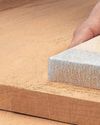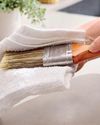Intentar ORO - Gratis
DECKING DURABILITY
The Home Handyman
|Mar/Apr'25
A well-maintained deck can last for years, providing a perfect outdoor retreat for family gatherings or solo relaxation. Whether your deck is exposed to baking sun or frequent rain, regular care will help keep it looking fresh and sturdy. This guide covers everything you need to know to maintain and enhance your decking, from seasonal maintenance to aesthetic upgrades and repairs.
-

Why deck maintenance matters
Preserving your investment
A deck can significantly add to your home’s value and extend your living space into the garden. However, without proper care, even the sturdiest wood can warp, rot, or crack over time. Exposure to weather elements, fluctuating temperatures, and foot traffic can accelerate wear and tear. Regular maintenance not only preserves the visual appeal of your deck but also prevents costly repairs down the line.
A neglected deck can quickly become unsafe, with loose boards and railings posing hazards to family and guests. By establishing a maintenance routine, you ensure your deck remains a safe, attractive part of your home for years to come.
Cleaning and preparation
Start with a clean slate
Before you can apply any protective treatments or repairs, your deck needs to be spotless. Dirt, moss, and algae can not only make your deck slippery but can also lead to rot if left unchecked. Cleaning your deck is the first step in extending its life and making it look its best.
STEP-BY-STEP CLEANING
1. Clear the area
Remove all furniture, planters, and accessories from the deck. This gives you full access to all the surfaces and prevents water damage to your belongings during the cleaning process.
2. Sweep thoroughly
Use a stiff broom to remove loose debris and leaves. Pay attention to gaps between boards, as organic matter trapped here can foster dampness and decay.
3. Wash down
Use a hose with a spray attachment to rinse the deck. For stubborn grime, a pressure washer on a low setting can help, but be careful not to damage the wood. Pressure washing should be done carefully, as using too high a setting can etch the wood, leaving it rough and prone to moisture absorption.
Esta historia es de la edición Mar/Apr'25 de The Home Handyman.
Suscríbete a Magzter GOLD para acceder a miles de historias premium seleccionadas y a más de 9000 revistas y periódicos.
¿Ya eres suscriptor? Iniciar sesión
MÁS HISTORIAS DE The Home Handyman

The Home Handyman
KEEP YOUR HOUSE CRITTER FREE
With winter fast approaching, outdoor critters seeking to regulate their temperature are trying their best to get inside. Ants, spiders, moths, mosquitoes, fruit flies, stink bugs, termites, silverfish, and ladybugs, to name a few, can easily make their way into homes, and once they've settled in, it's often hard to get them out.
6 mins
Jul/Aug'25

The Home Handyman
SECRET HIDEOUTS
We all have things we would prefer to keep out of plain sight - family heirlooms, wedding rings, expensive jewellery, medicines or even weapons. Sometimes we just want to keep household items hidden in order to declutter a space. Whether you want to hide items for safety or financial reasons, or simply want to keep your bedroom tidy, there are a few clever storage ideas that could help you out.
2 mins
Jul/Aug'25

The Home Handyman
ABRASIVES DEMYSTIFIED
Abrasive materials are indispensable in countless industries, from woodworking and metal fabrication to automotive repair and electronics manufacturing.
3 mins
Jul/Aug'25

The Home Handyman
THINNERS VS. TURPENTINE
If you've ever finished a painting or staining job and been left wondering how best to clean your brushes, you're not alone. One of the most common DIY questions is: Should I use thinners or turpentine to clean my brushes? The answer depends on the type of paint or coating you've used. Using the wrong solvent can damage your brushes, or worse, make the cleaning job even harder.
2 mins
Jul/Aug'25

The Home Handyman
KEEP THE COLD OUT
Did you know that homes in South Africa are either insulated to a poor standard, compared to European nations, or have no form of insulation at all. In 2011 our National Building Regulations made it compulsory to fit thermal insulation in new buildings and additions to building structures.
5 mins
Jul/Aug'25

The Home Handyman
ANGLE GRINDERS — MASTERING THIS VERSATILE TOOL
When it comes to versatile tools in a DIYer's arsenal, few can match the power and practicality of the angle grinder.
2 mins
Jul/Aug'25

The Home Handyman
KITCHEN CARE – MAINTENANCE TIPS FOR KEY AREAS
The kitchen is the heart of the home where meals are made, memories are shared, and chaos sometimes reigns. But like any hardworking space, your kitchen needs regular maintenance to keep it functional, safe, and looking great.
2 mins
Jul/Aug'25

The Home Handyman
Separating Fact from Fiction
Maintaining your home can be a daunting task, especially with the plethora of DIY tips and tricks floating around the internet.
2 mins
Jul/Aug'25

The Home Handyman
SEALANTS SIMPLIFIED: WHAT TO USE AND WHERE
Whether you’re tackling a weekend DIY fix, remodelling your home, or involved in large-scale construction, sealants are a silent hero that play a vital role in creating watertight, airtight, and secure finishes.
3 mins
Jul/Aug'25

The Home Handyman
COMMON FRIDGE/FREEZER FAULTS
Your fridge freezer is one of the hardest-working appliances in your home, so when it stops performing as it should, it can cause major inconvenience. The good news? Not every fault means an expensive call-out or a trip to the shops for a new one. In many cases, you can fix the issue yourself with a little know-how and a few basic tools.
3 mins
Jul/Aug'25
Listen
Translate
Change font size

